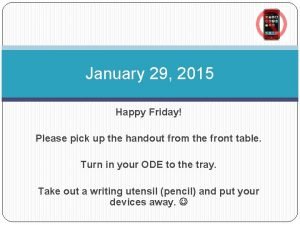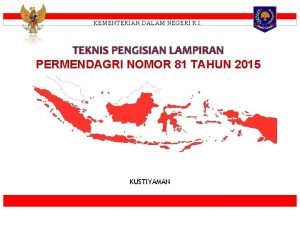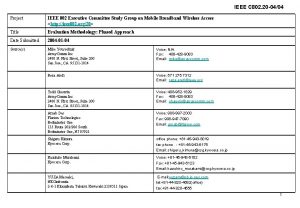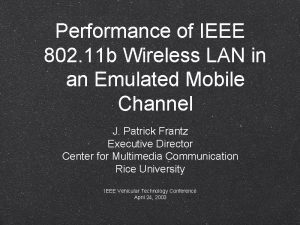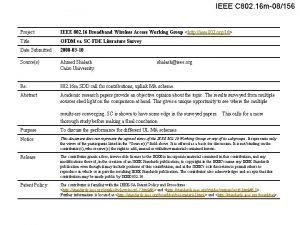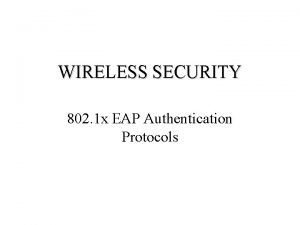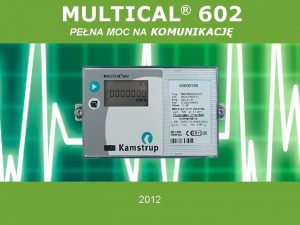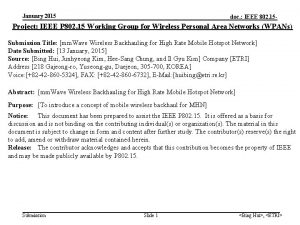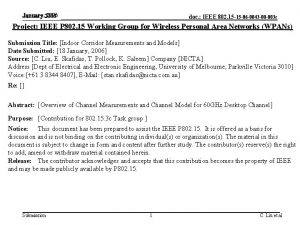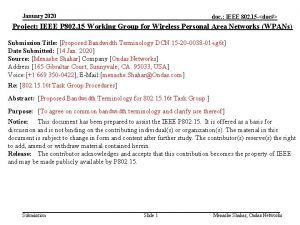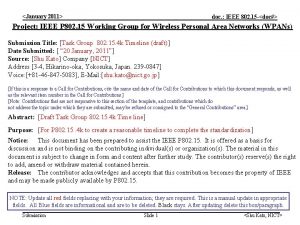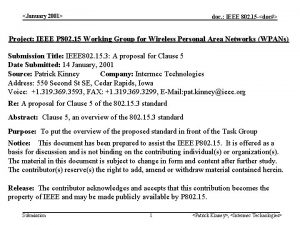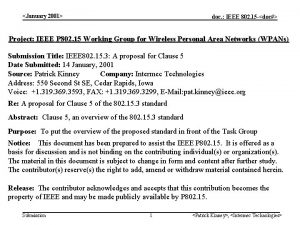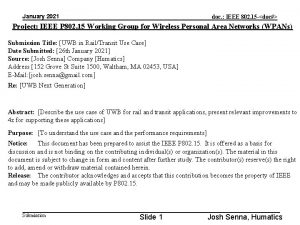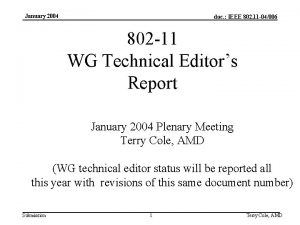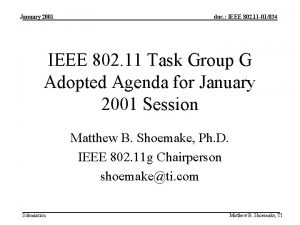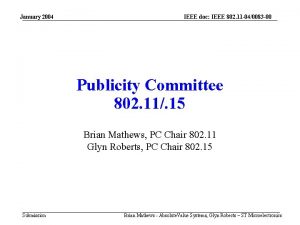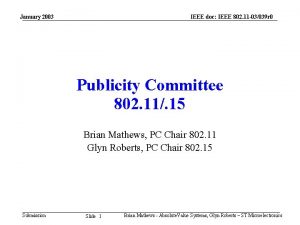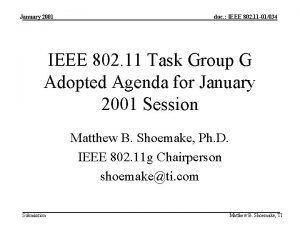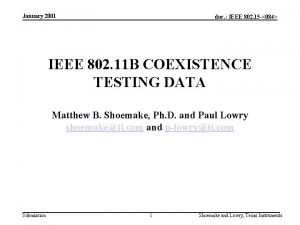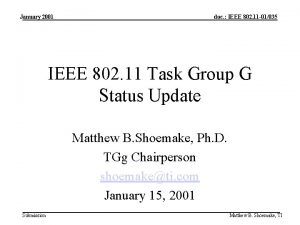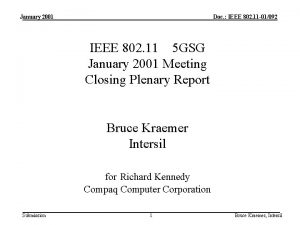January 2015 doc IEEE 802 11 150091 r

















![January 2015 doc. : IEEE 802. 11 -15/0091 r 0 Reference • • [1][14/1453/r January 2015 doc. : IEEE 802. 11 -15/0091 r 0 Reference • • [1][14/1453/r](https://slidetodoc.com/presentation_image_h2/d40572fbb571676767ed13f29302e618/image-18.jpg)
- Slides: 18

January 2015 doc. : IEEE 802. 11 -15/0091 r 0 UL-OFDMA procedure in IEEE 802. 11 ax • Date: 2015 -01 -12 Authors: Submission Slide 1 Woojin Ahn, Yonsei Univ.

January 2015 doc. : IEEE 802. 11 -15/0091 r 0 Introduction • • UL-OFDMA is included in Spec Framework Document for 11 ax [1], [2] − UL/DL-OFDMA is a key enabling technique to meet the requirement of throughput enhancement − Number of problem statement and solutions have been discussed in TGax [3], [4], [5], [6], [7] 11 ax is aiming to enhance the spectral efficiency − − • Finer granularity of bandwidth usage (2. 5/5 MHz BW) Aggressive wideband operation In this contribution, issues on UL-OFDMA procedure in 802. 11 ax, as well as possible solutions will be discussed − Submission With finer sub-channel, wideband operation, dense OBSS environment Slide 2 Woojin Ahn, Yonsei Univ.

January 2015 doc. : IEEE 802. 11 -15/0091 r 0 Issues on UL-OFDMA in 802. 11 • Lack of 1: N control mechanism − When and who to initiate UL-OFDMA? − Which STA to participate or to be selected? • Scheduling − How to protect data transmission(NAV) from multiple groups of hidden nodes − How to finish the whole procedure • ACK procedure • How do we Support UL-OFMDA in wideband dense OBSS environment? Submission Slide 3 Woojin Ahn, Yonsei Univ.

January 2015 doc. : IEEE 802. 11 -15/0091 r 0 When and who to initiate UL-OFDMA • Timing/power/frequency Synchronization − AP can calculate the timing/power/frequency differences among STAs • AP centralized initiation − AP indicates each STA to adjust time/frequency/power differences[5] − Trigger frame[3] • Periodic or scheduling − Following beacon period − Whenever scheduling status meets UL-OFDMA trigger condition − Depends on target situation, procedure development Submission Slide 4 Woojin Ahn, Yonsei Univ.

January 2015 doc. : IEEE 802. 11 -15/0091 r 0 Which STA should participate • AP doesn’t have any information on STAs’ buffer status • Conventional polling mechanism − Simple, stable, rich information • − Large overhead • • Unrestricted STA selection, data duration The more STA, the longer delay UL-request frame[3] • Submission Each STA sends UL request frame independently to indicate its buffer status to AP Slide 5 Woojin Ahn, Yonsei Univ.

January 2015 doc. : IEEE 802. 11 -15/0091 r 0 Which STA should participate • Buffer status feedback − Buffer status indication with ongoing tx/rx • Reusing duplicated or reserved field of preamble/header • Ex) group ID, NSTS, partial AID of UL transmission • More data, more fragment bit − Small overhead, limited information, restricted STA selection Submission Slide 6 Woojin Ahn, Yonsei Univ.

January 2015 doc. : IEEE 802. 11 -15/0091 r 0 NAV Protection • Each STA has different 3 rd party STAs − 3 rd party: STAs those only belong to tx STA’s (eg. , Fig. 1’s STA 1) radio range • In order to set NAV for every 3 rd party, each UL-tx STA must transmit at least one RTS or CTS − RTS/CTS with 802. 11 a format − Legacy STAs cannot read Data frame Submission Slide 7 Woojin Ahn, Yonsei Univ.

January 2015 doc. : IEEE 802. 11 -15/0091 r 0 NAV Protection • Serial RTS transmission − Large overhead − CTS time out • Reset NAV if no PHY-RXSTART. indication with a duration of (2 × a. SIFSTime) + (CTS_Time) + a. PHY-RX-START-Delay + (2 × a. Slot. Time) − CTS doesn’t have condition for resetting NAV Submission Slide 8 Woojin Ahn, Yonsei Univ.

January 2015 doc. : IEEE 802. 11 -15/0091 r 0 NAV setting using common CTS • ① CTS-to-STA group − − • Using CTS to prevent 3 rd party STAs from resetting NAV Assign a dedicated multicast address for 11 ax UL-OFDMA ② Common CTS[3] − Every UL-OFDMA participants send CTS with identical waveform • − Submission E. g. , DA: AP, SA: multicast address for 11 ax UL-OFDMA Resource allocation acknowledgement can be followed Slide 9 Woojin Ahn, Yonsei Univ.

January 2015 doc. : IEEE 802. 11 -15/0091 r 0 ACK procedure • Serial ACK transmission − Large overhead • Sub-channel based ACK − Less overhead − Unfairness between Legacy and ax STAs[8] • The STA having the shorter EIFS parameter has the higher channel access probability Submission Slide 10 Woojin Ahn, Yonsei Univ.

January 2015 doc. : IEEE 802. 11 -15/0091 r 0 ACK procedure using common ACK • Sub-channel based ACK − Acknowledgement of received data • Common ACK − Preventing legacy STAs from waiting for EIFS − Identical waveform Submission Slide 11 Woojin Ahn, Yonsei Univ.

January 2015 doc. : IEEE 802. 11 -15/0091 r 0 UL-OFDMA in wideband operation • In dense OBSS environment − STAs might belong to different OBSSs • AP triggers UL-OFDMA after CCA − The snapshot of CCA results could be different from each other − Which band should be assigned to which STAs? Submission Slide 12 Woojin Ahn, Yonsei Univ.

January 2015 doc. : IEEE 802. 11 -15/0091 r 0 UL-OFDMA in wideband operation • STAs should inform AP of both their buffer and CCA status • CCA feedback might also introduce massive overhead Submission Slide 13 Woojin Ahn, Yonsei Univ.

January 2015 doc. : IEEE 802. 11 -15/0091 r 0 Code based access • • Pseudo random code − Enhancing CSMA/CA performance via introducing code based contention mechanism[9], [10] − − PRACH, PUCCH, PUSCH in LTE Code assignment − − • CAZAC sequence (Zadoff-chu) Randomly chosen from code set Unique code for each STA Code access could play a role both for CCA feedback and buffer status indication − Every 11 ax STA that has uplink data simultaneously sends a chosen code to clear-assessed channels after CTS-to-STA group − Unrestricted STA selection, no data duration Submission Slide 14 Woojin Ahn, Yonsei Univ.

January 2015 doc. : IEEE 802. 11 -15/0091 r 0 Comparison of CCA feedback Submission Slide 15 Woojin Ahn, Yonsei Univ.

January 2015 doc. : IEEE 802. 11 -15/0091 r 0 Expected form of UL-OFDMA procedure Submission Slide 16 Woojin Ahn, Yonsei Univ.

January 2015 doc. : IEEE 802. 11 -15/0091 r 0 Conclusion • In this contribution, we discussed issues on UL-OFDMA procedure in 802. 11 ax, as well as possible solutions • UL-OFDMA might cause massive control overhead, and unstable transmission protection − Due to lack of multiple transmission control mechanism − Scheduling, 3 rd party NAV setting, ACK procedure, CCA feedback • We introduced several possible solutions to the discussed issues − − Submission Common CTS/ACK(identical wave form) transmission Code based access Slide 17 Woojin Ahn, Yonsei Univ.
![January 2015 doc IEEE 802 11 150091 r 0 Reference 1141453r January 2015 doc. : IEEE 802. 11 -15/0091 r 0 Reference • • [1][14/1453/r](https://slidetodoc.com/presentation_image_h2/d40572fbb571676767ed13f29302e618/image-18.jpg)
January 2015 doc. : IEEE 802. 11 -15/0091 r 0 Reference • • [1][14/1453/r 2] Spec Framework Proposal • • [3][14/1431/r 1] Issues on UL-OFDMA • • • [5][14/0802/r 0] Consideration on UL MU transmission [2][14/1447/r 1] Proposed Spec Framework Document for 11 ax considering potential tech features [4][14/1446/r 0] Analysis of frequency and power requirements for ULOFDMA [6][14/1190/r 2] Frame Exchange Control for Uplink Multi-user transmission [7][14/1232/r 1] On Multi-STA Aggregation Mechanism in 11 ax [8][14/1211/r 0] Ack Procedure for OFDMA [9][14/0616/r 0] CSMA/CA enhancements [10][14/1681/r 1] 802. 11 Tgax PHY Frame Structure Discussion for Enabling New Contention Mechanism Submission Slide 18 Woojin Ahn, Yonsei Univ.
 Bridges from 802.x to 802.y
Bridges from 802.x to 802.y Bridges from 802.x to 802.y
Bridges from 802.x to 802.y Ieee 802 standard
Ieee 802 standard Ieee 802 bluetooth
Ieee 802 bluetooth 802 ieee
802 ieee Ieee 802
Ieee 802 Ieee 802 family
Ieee 802 family Ieee 802 3 compliance
Ieee 802 3 compliance Ieee802.22
Ieee802.22 Arquitetura ieee 802
Arquitetura ieee 802 802 ieee
802 ieee January 29 2015
January 29 2015 Contoh laporan evaluasi perkembangan desa dan kelurahan
Contoh laporan evaluasi perkembangan desa dan kelurahan 802 20
802 20 802 11 b
802 11 b Mac address
Mac address 802 16
802 16 802 eap
802 eap Kamstrup multical 802
Kamstrup multical 802











